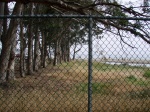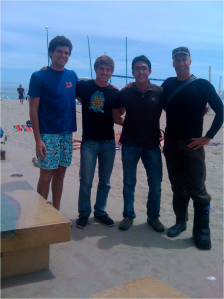Monday June 21st
We stopped by Stanford’s Hopkins Marine Station in Monterey to speak with Jim Watanabe, Professor of Marine Ecology. Sitting back in his office chair overlooking the pristine Monterey Bay kelp beds, Professor Watanabe told us about tube snails. These small mollusks used to only inhabit Southern California. In fact they were never seen anywhere near Monterey before 1980. Now tube snails inhabit nearly every stretch of rocky intertidal in Monterey. As the ocean and air temperatures warm, intertidal species migrate northward to remain their area of desired climate.
We wanted to see if Professor Jim’s story checked out, so we headed over to the Hopkins Library. Joe Wible, the Hopkins Librarian, let us take a look at Ed Ricketts old collecting cards from the 20’s and 30’s. We wanted to see where exactly Rickett’s had found tube worms 80 years ago. Ed Ricketts was a marine biologist, philosopher, and dear friend of John Steinbeck, who worked and lived in Cannery Row. His collecting cards thoroughly document all the marine life he examined between Vancouver and the Gulf of California. Most of his records were burned in a laboratory fire, but luckily for us, his cards from Monterey down to San Diego were saved. We waited as Joe Wible pulled out two shoeboxes from behind locked doors.
A reverent silence fell over us as Joe opened up the boxes. The very tops of the envelopes were charred from the laboratory fire. We realized that we were looking at cards that had been rescued from a fire over 70 years ago. On the cards themselves, Ricketts had carefully documented each organism by its full scientific name with its depth on tidal horizon, exposure to wave shock, type of bottom, and number observed. Browsing through the cards, we found a record of the tube worm, or as it was called in the early 20th century, aletes squamigerous. Confirming what Professor Watanabe had told us moments earlier, Ricketts observed no tube worms at all in Monterey during the 20’s and 30’s. However down in Southern California, Ricketts collected tube worms in the Laguna Beach Rocky Tide flats, E of the CIT Station in Newport Bay, and on the channel side rocks of the Newport jetty. The most amazing thing was seeing the dates next to Ricketts notes, the earliest being Nov 18 1930.
Professor Watanabe and Joe Wible wished us luck on our trip, and we were off to Stanford for some last minute prep.
If you want to see Professor Watanabe’s webpage, visit http://seanet.stanford.edu/
Better yet, if you want eyes light up ask him about the “mighty and rugged” mussel
-Ian



















